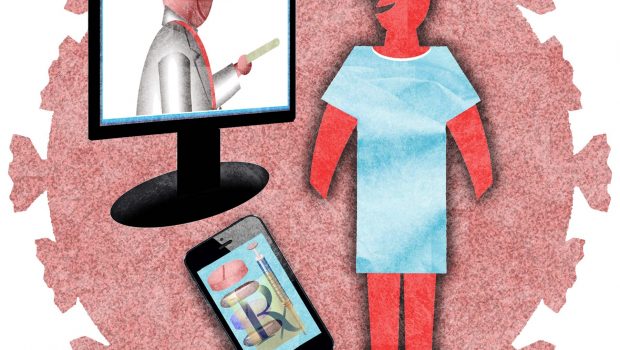Accelerated use of technology and data key to modernizing Medicare and Medicaid
OPINION:
Government is slow to adopt the latest technology – smartphones, wellness apps, telehealth – that most Americans use to manage their health daily. In fact, Medicare and Medicaid are decades behind the private sector in adopting and using these tools. As a result, patients go undiagnosed, disease needlessly progresses, and costs for patients and taxpayers continue to rise. But a powerful new approach is brewing to change all that.
House Republicans have been working for months on policies to modernize government programs like Medicare and Medicaid through accelerated use of technology and data. If Republicans take the House in November, you can expect reforms that will expand access to care, put patients in control of their health information, and begin to pay for programs and apps that keep people healthy.
The goal is to make Medicare and other government programs work better for consumers and taxpayers. For too long, our health care has been held back by a maze of government rules and processes that inhibit modernization at the speed of science and medicine.
Why? It takes an act of Congress or a federal bureaucrat to expand coverage for innovative technologies in Medicare. Because it is difficult to pass laws, Medicare is updated slowly over time. Representatives Mariannette Miller-Meeks (IA), Mike Kelly (PA), and Morgan Griffith (VA) – who were tasked by Republican leaders to develop a game plan – recently outlined the House Republican Healthy Futures Modernization agenda to get technological health advances into the hands of patients faster.
An example is telehealth, a widely used tool to enhance access to care. Before COVID-19, government rules prevented the use of telehealth in a patient’s home. People had to drive to a hospital or physician’s office to access telehealth, which defeats the purpose. Less than one million people accessed Medicare’s telehealth benefit.
During COVID-19, the government lifted the rules, and access to care greatly improved. Fifty-six million people accessed care via telehealth in 2021 alone. Unfortunately, when the COVID-19 public health emergency ends, the dumb rules snap back into place, ending easy access to telehealth unless Congress acts. The Healthy Futures agenda would permanently make remote access a part of the Medicare benefit.
Another example is waste and fraud in government programs. Medicare loses about $70 billion each year to errors, fraud, and abuse. Current efforts to combat fraud have hinged on expensive, frequent audits of providers, chasing crooks after they’ve been paid, and requiring patients to see doctors in person before using remote care. But the private sector long ago adopted the use of Artificial Intelligence to combat improper payments. These models outperform government strategies because they incorporate more factors that can predict fraud and because it is easier and faster to retrain models to keep up with or stay ahead of fraudsters.
While there will always be bad actors, Congress can take steps to ensure HHS and CMS have the resources necessary to identify and reduce fraud in real time. Fortunately, Medicare and its fraud units already have a strategic plan in place to leverage AI and Machine Learning to better predict the potential for fraud, waste, and abuse while supporting the oversight of future programs. The Healthy Futures agenda would dramatically expand the use of AI to safeguard taxpayer resources.
Medicare and Medicaid fail to adopt and make available innovative, patient-centered technologies. When they do, it often takes years to approve coverage and pay for novel, technology-enabled treatments, and diagnostics.
One example is the solution created by Digital Diagnostics, whose fight against eye disease is starting to take off. With investments from the University of Iowa, Digital Diagnostics became the first company to ever receive government approval for an AI platform that makes a diagnosis without physician input at the point of care. This innovation means millions of patients at risk for diabetic eye disease and blindness can be assessed quickly and receive timely care from a doctor. Their solution expands access to care sooner when treatment is more effective, and without increasing costs.
Medicare, the largest single payer of services in the U.S., decided to pay for it in November last year, four years after the product was approved. That’s too long to adopt the technology. The Healthy Futures agenda envisions a Medicare program that moves with the speed of science and medicine, not bureaucracy. Congress should revive the Trump-era program to expedite Medicare coverage for breakthrough devices.
The Healthy Futures agenda envisions a system that tailors coverage to consumers, where consumers and doctors have access to and control of all the necessary information to treat and manage illnesses should be the cornerstone of any system.
Health care decisions are made locally by patients and their doctors, but the rules are set thousands of miles away in Washington by politicians and bureaucrats. Empowered consumers can drive down costs far better than inflexible rules flowing from our nation’s capital, but they need the technology and data to do so.
That’s not what we have today in Medicare or Medicaid, but it is what the Healthy Futures agenda envisions for all Americans.
• Joel White is the Executive Director of the Health Innovation Alliance, is a broad-based coalition focused on creating value for patients by advancing technology and data policy.








Gloss